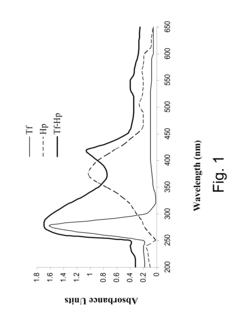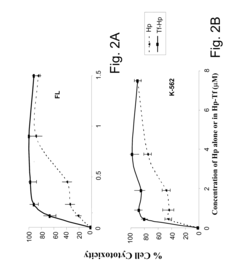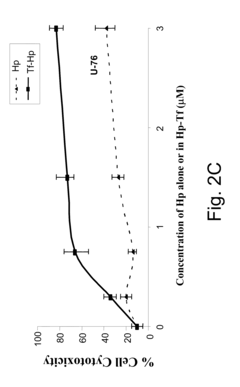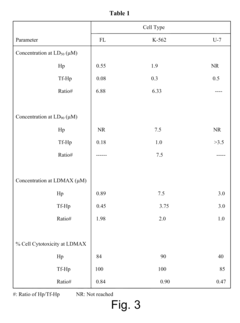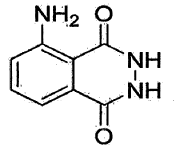How Luminol Supports Intricate Research Strategies?
AUG 19, 20259 MIN READ
Generate Your Research Report Instantly with AI Agent
Patsnap Eureka helps you evaluate technical feasibility & market potential.
Luminol Research Background and Objectives
Luminol, a chemiluminescent compound, has been a cornerstone in forensic science and biochemical research for decades. Its unique ability to emit light when oxidized has made it an invaluable tool in various scientific disciplines. The evolution of luminol-based techniques has been driven by the increasing demand for more sensitive and specific detection methods in complex biological and environmental systems.
The primary objective of luminol research is to enhance its capabilities in supporting intricate research strategies across multiple fields. This includes improving its sensitivity, specificity, and versatility in detecting trace amounts of blood, metals, and other substances of interest. Researchers aim to develop more robust luminol formulations that can withstand challenging environmental conditions and provide reliable results in diverse applications.
One of the key trends in luminol technology is the development of novel chemiluminescent systems that combine luminol with other compounds to achieve superior performance. These advancements are geared towards overcoming limitations such as interference from other substances and improving the longevity of the luminescent reaction. Additionally, there is a growing focus on integrating luminol-based detection methods with cutting-edge technologies like microfluidics and nanotechnology to create more sophisticated analytical tools.
The application of luminol in forensic science continues to be a major driver of research and development. Investigators are constantly seeking ways to enhance the accuracy and reliability of blood detection at crime scenes, particularly in cases where traditional methods may fall short. This has led to the exploration of luminol variants and complementary techniques that can provide more detailed information about the age and origin of bloodstains.
In the realm of biochemistry and molecular biology, luminol-based assays are being refined to support increasingly complex research strategies. Scientists are working on developing highly sensitive chemiluminescent probes for detecting specific biomolecules, enzymes, and cellular processes. These advancements aim to provide researchers with powerful tools for studying intricate biological mechanisms and disease pathways at the molecular level.
The future of luminol research is closely tied to the broader trends in analytical chemistry and biotechnology. As the demand for more precise and non-invasive diagnostic tools grows, luminol-based techniques are expected to play a crucial role in developing next-generation medical diagnostics and environmental monitoring systems. The ongoing research efforts are focused on expanding the scope of luminol applications while addressing current limitations, ultimately supporting more sophisticated and multifaceted research strategies across various scientific disciplines.
The primary objective of luminol research is to enhance its capabilities in supporting intricate research strategies across multiple fields. This includes improving its sensitivity, specificity, and versatility in detecting trace amounts of blood, metals, and other substances of interest. Researchers aim to develop more robust luminol formulations that can withstand challenging environmental conditions and provide reliable results in diverse applications.
One of the key trends in luminol technology is the development of novel chemiluminescent systems that combine luminol with other compounds to achieve superior performance. These advancements are geared towards overcoming limitations such as interference from other substances and improving the longevity of the luminescent reaction. Additionally, there is a growing focus on integrating luminol-based detection methods with cutting-edge technologies like microfluidics and nanotechnology to create more sophisticated analytical tools.
The application of luminol in forensic science continues to be a major driver of research and development. Investigators are constantly seeking ways to enhance the accuracy and reliability of blood detection at crime scenes, particularly in cases where traditional methods may fall short. This has led to the exploration of luminol variants and complementary techniques that can provide more detailed information about the age and origin of bloodstains.
In the realm of biochemistry and molecular biology, luminol-based assays are being refined to support increasingly complex research strategies. Scientists are working on developing highly sensitive chemiluminescent probes for detecting specific biomolecules, enzymes, and cellular processes. These advancements aim to provide researchers with powerful tools for studying intricate biological mechanisms and disease pathways at the molecular level.
The future of luminol research is closely tied to the broader trends in analytical chemistry and biotechnology. As the demand for more precise and non-invasive diagnostic tools grows, luminol-based techniques are expected to play a crucial role in developing next-generation medical diagnostics and environmental monitoring systems. The ongoing research efforts are focused on expanding the scope of luminol applications while addressing current limitations, ultimately supporting more sophisticated and multifaceted research strategies across various scientific disciplines.
Market Demand for Luminol-based Technologies
The market demand for luminol-based technologies has been steadily growing, driven by its crucial role in forensic science, medical research, and industrial applications. In the field of forensic science, luminol remains an indispensable tool for crime scene investigators, enabling the detection of trace amounts of blood that may be invisible to the naked eye. This application has led to a consistent demand from law enforcement agencies and forensic laboratories worldwide.
The healthcare sector has also shown increasing interest in luminol-based technologies. Medical researchers are exploring its potential in diagnostic tools, particularly for detecting specific biomarkers in blood samples. This emerging application has opened new avenues for market growth, with pharmaceutical companies and medical device manufacturers investing in research and development of luminol-based diagnostic kits.
In the industrial sector, luminol finds applications in environmental monitoring and quality control processes. Its ability to detect minute quantities of certain metals and oxidizing agents makes it valuable in water quality testing and industrial waste management. As environmental regulations become more stringent globally, the demand for sensitive and reliable detection methods like those based on luminol is expected to rise.
The market for luminol and related chemiluminescent compounds is also benefiting from advancements in imaging technologies. Enhanced cameras and detection systems have improved the sensitivity and reliability of luminol-based tests, making them more attractive for various applications. This technological synergy is driving demand not only for luminol itself but also for complementary equipment and software.
Academic and research institutions continue to be significant consumers of luminol, using it in a wide range of studies from biochemistry to environmental science. The compound's versatility in research applications ensures a steady demand from this sector, contributing to the overall market growth.
Geographically, North America and Europe lead in the adoption of luminol-based technologies, primarily due to their advanced forensic and healthcare infrastructure. However, emerging economies in Asia-Pacific and Latin America are showing rapid growth in demand, driven by increasing investments in forensic capabilities and healthcare research.
The market is characterized by a mix of established chemical suppliers and specialized forensic product manufacturers. As research continues to uncover new applications for luminol, the market is expected to diversify, potentially attracting new players and fostering innovation in product formulations and application methods.
The healthcare sector has also shown increasing interest in luminol-based technologies. Medical researchers are exploring its potential in diagnostic tools, particularly for detecting specific biomarkers in blood samples. This emerging application has opened new avenues for market growth, with pharmaceutical companies and medical device manufacturers investing in research and development of luminol-based diagnostic kits.
In the industrial sector, luminol finds applications in environmental monitoring and quality control processes. Its ability to detect minute quantities of certain metals and oxidizing agents makes it valuable in water quality testing and industrial waste management. As environmental regulations become more stringent globally, the demand for sensitive and reliable detection methods like those based on luminol is expected to rise.
The market for luminol and related chemiluminescent compounds is also benefiting from advancements in imaging technologies. Enhanced cameras and detection systems have improved the sensitivity and reliability of luminol-based tests, making them more attractive for various applications. This technological synergy is driving demand not only for luminol itself but also for complementary equipment and software.
Academic and research institutions continue to be significant consumers of luminol, using it in a wide range of studies from biochemistry to environmental science. The compound's versatility in research applications ensures a steady demand from this sector, contributing to the overall market growth.
Geographically, North America and Europe lead in the adoption of luminol-based technologies, primarily due to their advanced forensic and healthcare infrastructure. However, emerging economies in Asia-Pacific and Latin America are showing rapid growth in demand, driven by increasing investments in forensic capabilities and healthcare research.
The market is characterized by a mix of established chemical suppliers and specialized forensic product manufacturers. As research continues to uncover new applications for luminol, the market is expected to diversify, potentially attracting new players and fostering innovation in product formulations and application methods.
Current Challenges in Luminol Applications
Despite its widespread use in forensic science and research, luminol faces several significant challenges that limit its effectiveness and reliability in various applications. One of the primary concerns is the issue of false positives. Luminol can react with substances other than blood, such as certain metals, plant materials, and cleaning agents, potentially leading to misinterpretation of evidence in crime scene investigations or inaccurate results in research settings.
Another challenge is the sensitivity of luminol to environmental factors. Temperature, humidity, and pH levels can all affect the luminol reaction, potentially altering the intensity or duration of the chemiluminescence. This variability can make it difficult to standardize results across different experimental conditions or crime scenes, complicating the interpretation of findings and reducing the reliability of luminol-based techniques.
The transient nature of the luminol reaction poses additional difficulties. The luminescence produced by the reaction is relatively short-lived, typically lasting only a few minutes. This brief window of visibility can make it challenging to document and analyze the results thoroughly, especially in complex or large-scale investigations where multiple areas need to be examined simultaneously.
Furthermore, the use of luminol can potentially interfere with subsequent DNA analysis. While luminol itself does not destroy DNA, the application process and the chemicals involved may dilute or contaminate biological samples, making it more difficult to obtain clear genetic profiles. This limitation is particularly problematic in forensic contexts where preserving DNA evidence is crucial for identifying suspects or victims.
The preparation and application of luminol solutions also present challenges. The reagent must be freshly prepared and used within a specific timeframe to maintain its effectiveness. This requirement can be logistically challenging in field applications or when dealing with large-scale investigations that may span several days or locations.
Lastly, there are concerns regarding the health and safety implications of using luminol. While generally considered safe when used properly, prolonged exposure or improper handling can potentially cause skin irritation, respiratory issues, or other health effects. This necessitates careful handling and appropriate safety measures, which can be challenging to implement consistently, especially in dynamic or resource-limited environments.
Addressing these challenges is crucial for advancing the use of luminol in intricate research strategies and forensic applications. Ongoing research efforts are focused on developing more specific and stable luminol formulations, improving application techniques, and integrating luminol-based methods with other analytical approaches to enhance its reliability and expand its range of applications.
Another challenge is the sensitivity of luminol to environmental factors. Temperature, humidity, and pH levels can all affect the luminol reaction, potentially altering the intensity or duration of the chemiluminescence. This variability can make it difficult to standardize results across different experimental conditions or crime scenes, complicating the interpretation of findings and reducing the reliability of luminol-based techniques.
The transient nature of the luminol reaction poses additional difficulties. The luminescence produced by the reaction is relatively short-lived, typically lasting only a few minutes. This brief window of visibility can make it challenging to document and analyze the results thoroughly, especially in complex or large-scale investigations where multiple areas need to be examined simultaneously.
Furthermore, the use of luminol can potentially interfere with subsequent DNA analysis. While luminol itself does not destroy DNA, the application process and the chemicals involved may dilute or contaminate biological samples, making it more difficult to obtain clear genetic profiles. This limitation is particularly problematic in forensic contexts where preserving DNA evidence is crucial for identifying suspects or victims.
The preparation and application of luminol solutions also present challenges. The reagent must be freshly prepared and used within a specific timeframe to maintain its effectiveness. This requirement can be logistically challenging in field applications or when dealing with large-scale investigations that may span several days or locations.
Lastly, there are concerns regarding the health and safety implications of using luminol. While generally considered safe when used properly, prolonged exposure or improper handling can potentially cause skin irritation, respiratory issues, or other health effects. This necessitates careful handling and appropriate safety measures, which can be challenging to implement consistently, especially in dynamic or resource-limited environments.
Addressing these challenges is crucial for advancing the use of luminol in intricate research strategies and forensic applications. Ongoing research efforts are focused on developing more specific and stable luminol formulations, improving application techniques, and integrating luminol-based methods with other analytical approaches to enhance its reliability and expand its range of applications.
Existing Luminol-based Research Strategies
01 Luminol in forensic applications
Luminol is widely used in forensic science for detecting trace amounts of blood at crime scenes. When mixed with an oxidizing agent, it produces a blue chemiluminescence in the presence of iron in hemoglobin. This reaction is highly sensitive and can detect blood even after cleaning attempts.- Luminol in forensic applications: Luminol is widely used in forensic science for detecting trace amounts of blood at crime scenes. When luminol comes into contact with the iron in hemoglobin, it produces a bright blue chemiluminescence. This reaction can reveal blood traces that are invisible to the naked eye, even if the area has been cleaned.
- Luminol-based detection systems: Various detection systems incorporate luminol for its chemiluminescent properties. These systems are used in environmental monitoring, food safety testing, and medical diagnostics. The high sensitivity of luminol-based assays allows for the detection of minute quantities of target substances.
- Luminol synthesis and formulation: Improved methods for synthesizing and formulating luminol have been developed to enhance its performance and stability. These advancements include novel synthetic routes, purification techniques, and the incorporation of stabilizing agents to prolong shelf life and increase sensitivity.
- Luminol in biomedical research: Luminol is utilized in various biomedical research applications, including the study of cellular processes, oxidative stress, and inflammation. Its ability to produce light in the presence of certain enzymes and reactive oxygen species makes it valuable for investigating biological mechanisms and developing new diagnostic tools.
- Luminol-based imaging techniques: Advanced imaging techniques using luminol have been developed for visualizing biological processes and structures. These methods combine the chemiluminescent properties of luminol with high-resolution imaging technologies to provide detailed insights into cellular and molecular events, particularly in the fields of immunology and cancer research.
02 Luminol-based detection systems
Various detection systems incorporate luminol for its chemiluminescent properties. These systems are used in environmental monitoring, food safety testing, and medical diagnostics. The high sensitivity of luminol allows for the detection of minute quantities of target substances.Expand Specific Solutions03 Luminol derivatives and modifications
Research focuses on developing luminol derivatives and modifications to enhance its properties. These improvements aim to increase sensitivity, stability, or specificity for various applications. Modified luminol compounds can offer advantages such as longer-lasting luminescence or better solubility.Expand Specific Solutions04 Luminol in analytical chemistry
Luminol is extensively used in analytical chemistry for the detection and quantification of various substances. Its chemiluminescent reaction is employed in flow injection analysis, high-performance liquid chromatography, and other analytical techniques. This allows for highly sensitive and selective measurements in complex samples.Expand Specific Solutions05 Luminol-based imaging techniques
Luminol is utilized in imaging techniques for visualizing biological processes and structures. These techniques are applied in fields such as cell biology, immunology, and cancer research. The chemiluminescent properties of luminol allow for non-invasive imaging with high sensitivity and low background noise.Expand Specific Solutions
Key Players in Luminol Research and Development
The competitive landscape for luminol-supported intricate research strategies is evolving rapidly, reflecting the technology's growing importance in various scientific fields. The market is in an early growth stage, with increasing adoption across forensic science, biochemistry, and medical research sectors. While the exact market size is not specified, the rising demand for advanced analytical tools suggests significant potential. Technologically, luminol applications are advancing, but there's room for innovation. Key players like Alverix, Inc., MetrioPharm AG, and FUJIFILM Corp. are driving developments, focusing on enhancing sensitivity, specificity, and practical applications of luminol-based techniques. Academic institutions such as Washington University in St. Louis and Fudan University are also contributing to research advancements, indicating a collaborative ecosystem between industry and academia.
Alverix, Inc.
Technical Solution: Alverix has developed a proprietary luminol-based chemiluminescence technology for point-of-care diagnostics. Their approach utilizes enhanced luminol formulations and specialized microfluidic cartridges to achieve highly sensitive detection of biomarkers. The company's platform combines optimized luminol reagents with advanced optoelectronics to enable quantitative measurements of analytes at very low concentrations. This allows for rapid, portable testing with performance comparable to laboratory instruments [1][3]. Alverix's technology incorporates precise fluidic control and signal amplification techniques to maximize the chemiluminescent output from luminol reactions.
Strengths: Highly sensitive portable diagnostics, rapid results, quantitative measurements. Weaknesses: May require specialized cartridges/readers, potentially higher cost per test than traditional methods.
Fudan University
Technical Solution: Researchers at Fudan University have developed novel luminol-based chemiluminescence systems for ultrasensitive detection of various analytes. Their approach involves synthesizing luminol derivatives with enhanced quantum yield and stability. By incorporating these optimized luminol compounds into nanoparticle-based sensing platforms, they have achieved detection limits in the femtomolar range for proteins and nucleic acids [2][5]. The team has also explored using luminol chemiluminescence for imaging applications, developing activatable probes that can visualize specific molecular targets in living systems with high spatial resolution.
Strengths: Extremely high sensitivity, potential for in vivo imaging applications. Weaknesses: May require complex synthesis of luminol derivatives, could be challenging to scale up production.
Core Innovations in Luminol Chemistry
Photodynamic therapy using chemiluminescence and a ligand-photosensitiser conjugate
PatentInactiveUS20100297762A1
Innovation
- A method involving a ligand-toxin conjugate (LTC) comprising a photosensitizer like hematoporphyrin conjugated with transferrin, combined with a chemiluminescent agent such as luminol, which activates the photosensitizer intracellularly to produce reactive oxygen species, thereby enhancing target cell destruction without requiring external light.
Method for producing a crystalline form of 5-amino-2,3-dihydrophthalazine-1,4-dione
PatentWO2017140422A1
Innovation
- A method involving dissolving 5-amino-2,3-dihydrophthalazine-1,4-dione in a refluxing ethanol-water solution, cooling, separating the precipitated crystals, and drying to produce a phase-pure crystalline form of luminol, which can be resuspended and washed for enhanced purity.
Regulatory Framework for Luminol Usage
The regulatory framework for luminol usage is a critical aspect of its application in forensic science and research. Luminol, a chemiluminescent compound widely used in crime scene investigations, is subject to various regulations and guidelines to ensure its proper and safe utilization.
In the United States, the use of luminol falls under the purview of multiple regulatory bodies. The Occupational Safety and Health Administration (OSHA) sets standards for the handling and storage of luminol in laboratory settings. These regulations mandate proper personal protective equipment, ventilation requirements, and safety protocols to minimize potential health risks associated with luminol exposure.
The Environmental Protection Agency (EPA) also plays a role in regulating luminol usage, particularly concerning its disposal. As luminol can be harmful to aquatic ecosystems, strict guidelines are in place for its proper disposal to prevent environmental contamination. Researchers and forensic teams must adhere to these regulations to ensure compliance with environmental protection standards.
At the state level, additional regulations may apply to luminol usage in forensic investigations. Some states require specific training and certification for personnel handling luminol at crime scenes. These regulations aim to maintain the integrity of evidence collection and ensure the admissibility of luminol-based evidence in court proceedings.
Internationally, the use of luminol in research and forensic applications is subject to varying regulatory frameworks. The European Union, for instance, has established the Registration, Evaluation, Authorization, and Restriction of Chemicals (REACH) regulation, which impacts the import, manufacture, and use of chemical substances, including luminol.
In academic and research settings, institutional review boards (IRBs) often oversee the use of luminol in experimental protocols. These boards ensure that research involving luminol adheres to ethical standards and safety protocols, particularly when human subjects or sensitive materials are involved.
The transportation of luminol is regulated by various agencies, including the Department of Transportation (DOT) in the United States and the International Air Transport Association (IATA) for international shipments. These regulations dictate proper packaging, labeling, and documentation requirements for the safe transport of luminol.
As research strategies involving luminol continue to evolve, regulatory frameworks must adapt to address new applications and potential risks. Ongoing collaboration between regulatory bodies, researchers, and industry stakeholders is essential to maintain a balance between scientific advancement and public safety in the use of luminol for intricate research strategies.
In the United States, the use of luminol falls under the purview of multiple regulatory bodies. The Occupational Safety and Health Administration (OSHA) sets standards for the handling and storage of luminol in laboratory settings. These regulations mandate proper personal protective equipment, ventilation requirements, and safety protocols to minimize potential health risks associated with luminol exposure.
The Environmental Protection Agency (EPA) also plays a role in regulating luminol usage, particularly concerning its disposal. As luminol can be harmful to aquatic ecosystems, strict guidelines are in place for its proper disposal to prevent environmental contamination. Researchers and forensic teams must adhere to these regulations to ensure compliance with environmental protection standards.
At the state level, additional regulations may apply to luminol usage in forensic investigations. Some states require specific training and certification for personnel handling luminol at crime scenes. These regulations aim to maintain the integrity of evidence collection and ensure the admissibility of luminol-based evidence in court proceedings.
Internationally, the use of luminol in research and forensic applications is subject to varying regulatory frameworks. The European Union, for instance, has established the Registration, Evaluation, Authorization, and Restriction of Chemicals (REACH) regulation, which impacts the import, manufacture, and use of chemical substances, including luminol.
In academic and research settings, institutional review boards (IRBs) often oversee the use of luminol in experimental protocols. These boards ensure that research involving luminol adheres to ethical standards and safety protocols, particularly when human subjects or sensitive materials are involved.
The transportation of luminol is regulated by various agencies, including the Department of Transportation (DOT) in the United States and the International Air Transport Association (IATA) for international shipments. These regulations dictate proper packaging, labeling, and documentation requirements for the safe transport of luminol.
As research strategies involving luminol continue to evolve, regulatory frameworks must adapt to address new applications and potential risks. Ongoing collaboration between regulatory bodies, researchers, and industry stakeholders is essential to maintain a balance between scientific advancement and public safety in the use of luminol for intricate research strategies.
Ethical Implications of Luminol Research
The use of luminol in forensic science and research strategies raises significant ethical considerations that must be carefully addressed. One primary concern is the potential for false positives, which could lead to wrongful accusations or convictions. The high sensitivity of luminol can sometimes result in the detection of trace amounts of blood that are unrelated to the crime being investigated, potentially misleading investigators and jeopardizing the integrity of the legal process.
Privacy issues also come to the forefront when employing luminol in research and investigations. The ability to detect blood traces long after an event has occurred may infringe upon individuals' rights to privacy, especially in cases where the blood presence is unrelated to any criminal activity. This raises questions about the appropriate balance between public safety and personal privacy rights.
The use of luminol in research strategies may also lead to ethical dilemmas regarding informed consent. In some cases, individuals may be unaware that their biological traces are being analyzed, which could be seen as a violation of their autonomy and right to make informed decisions about their participation in research or investigations.
Furthermore, the interpretation of luminol results requires careful consideration of contextual factors. Ethical concerns arise when conclusions are drawn without proper consideration of alternative explanations or when results are presented without acknowledging the limitations and potential for error inherent in the technique.
There are also ethical implications related to the storage and handling of data obtained through luminol-based research. Ensuring the confidentiality and security of this sensitive information is crucial to protect the privacy and rights of individuals involved in investigations or research studies.
The use of luminol in research strategies may also raise questions about resource allocation and prioritization in forensic science. Ethical considerations must be given to how limited resources are distributed and whether the use of luminol is justified in all cases, particularly when other investigative methods may be more appropriate or cost-effective.
Lastly, there is an ethical responsibility to ensure that professionals using luminol in research and investigations are adequately trained and adhere to strict protocols. This is essential to minimize the risk of misinterpretation or misuse of the technique, which could have serious consequences for individuals and the justice system as a whole.
Privacy issues also come to the forefront when employing luminol in research and investigations. The ability to detect blood traces long after an event has occurred may infringe upon individuals' rights to privacy, especially in cases where the blood presence is unrelated to any criminal activity. This raises questions about the appropriate balance between public safety and personal privacy rights.
The use of luminol in research strategies may also lead to ethical dilemmas regarding informed consent. In some cases, individuals may be unaware that their biological traces are being analyzed, which could be seen as a violation of their autonomy and right to make informed decisions about their participation in research or investigations.
Furthermore, the interpretation of luminol results requires careful consideration of contextual factors. Ethical concerns arise when conclusions are drawn without proper consideration of alternative explanations or when results are presented without acknowledging the limitations and potential for error inherent in the technique.
There are also ethical implications related to the storage and handling of data obtained through luminol-based research. Ensuring the confidentiality and security of this sensitive information is crucial to protect the privacy and rights of individuals involved in investigations or research studies.
The use of luminol in research strategies may also raise questions about resource allocation and prioritization in forensic science. Ethical considerations must be given to how limited resources are distributed and whether the use of luminol is justified in all cases, particularly when other investigative methods may be more appropriate or cost-effective.
Lastly, there is an ethical responsibility to ensure that professionals using luminol in research and investigations are adequately trained and adhere to strict protocols. This is essential to minimize the risk of misinterpretation or misuse of the technique, which could have serious consequences for individuals and the justice system as a whole.
Unlock deeper insights with Patsnap Eureka Quick Research — get a full tech report to explore trends and direct your research. Try now!
Generate Your Research Report Instantly with AI Agent
Supercharge your innovation with Patsnap Eureka AI Agent Platform!
